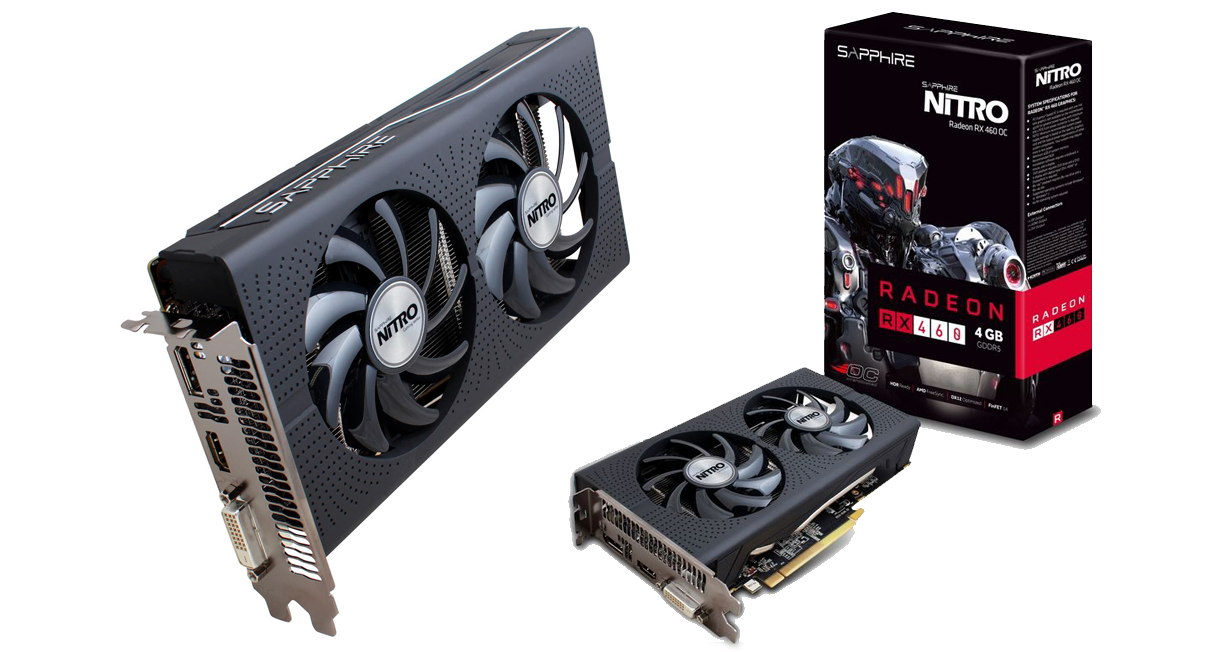Because PC parts in the Philippines are always going to be more expensive pound-for-pound compared to first world markets, advice such as get X because it’s only USD 10 more expensive than Y isn’t really applicable here. That allows cards like the RX 460 to shine because there is a significant premium between it and the next step up, the RX 470. In this issue, we take a look at the Sapphire Nitro Radeon RX 460 OC 4GB, an aggressively priced card designed for entry-level rigs.
Specifications:
- Stream Processors: 896
- Compute Units: 14
- Core Speed: 1175 MHz base clock; 1250 MHz boost clock
- VRAM: 4 GB GDDR5
- Memory Clock Speed: 1750 MHz
- Memory Interface: 128-bit
- Memory Bandwidth: 112 GB/s
- Power Requirement: 75 W; 6-pin power connector required; 450 W PSU recommended
- Output: DisplayPort 1.4, HDMI 2.0b, dual-link DVI-D
- Features: AMD FreeSync, Liquid VR, CrossFire, Eyefinity, PowerTune, ZeroCore Power, and TressFX; HDR Support, Vulkan, DirectX 12
- Dimensions: Dual slot; 221 X 123 X 38mm (L x W x D); 344 g
Design: 4.5/5
It’s an entry-level card and I expected an entry-level design but Sapphire really nailed it with this one. The aesthetics would’ve been “meh” had it been placed in a higher tier, but since we’re talking about a member of the lowest pecking order here, the typical Nitro design is more than welcome.
Sapphire’s RX 460 rocks the Dual-X cooling system composed of two nine-bladed 90 mm fans, two heat pipes, and a sizeable fin array. The latter two are well concealed by the dotted matte black shroud that wraps around the edges of the card.
Branding marques are present though they are not too tacky. There’s the Sapphire logo at the shroud’s top edge, Nitro stickers on the fans’ bearings, and the Nitro logo at the card’s rear. And because a gaming card nowadays isn’t complete without LED, the Nitro logo glows green (uhm, yay Team Red?) and the fans have a faint blue LED backlighting.
Hardware: 4/5
While you have the display I/O on one end of the card, it’s important to note that the Nitro RX 460 comes with a 6-pin supplementary power connector on the other. This means that systems that are already at the upper limit of their power requirement need a more capable PSU as this card needs a little more juice to run than other PCIe-only RX 460s.
It struts the same Polaris 11 architecture found on other RX 400 series cards, with 14 compute units and 896 stream processors clocked at 1175 MHz, boosting to an impressive 1250 MHz when needed. It’s paired to a 1750 MHz 4 GB GDDR5X frame buffer on a 128-bit bus, resulting in an overall 112 GB/s of memory bandwidth.
User Experience: 4/5
I installed the card in a rig with an Intel Core i5-4460 processor clocked at 3.2 GHz and 8 GB of DDR3 memory. All the tests were done at 1080p.
The Sapphire Nitro Radeon RX 460 OC 4GB0 churned out respectable framerates in almost all the titles I tested it with, namely Assassin’s Creed: Syndicate, Middle Earth: Shadow of Mordor, DiRT Rally, Ashes of the Singularity, and Fallout 4. Not only did the aggressive overclock out of the box enable it to produce smoother and better-looking visuals, the 4 GB frame buffer also allowed textures to be rendered at higher settings. Just dial back the other graphics setting to medium and you’re all set for a solid 30 fps experience.
As the RX 460 is marketed as an eSports card, I also tested it using DOTA 2, Overwatch, and Counter Strike: Global Offensive and it’s buttery smooth even at high settings. If all you’re going to be playing are non-graphics intensive games like the ones above, this card right here is sheer value for money.
Value: 4/5
The 4 GB variant of the Sapphire Nitro Radeon RX 460 retails for around PHP 7,000, a reasonable price given that it has plenty of frame buffer for ever-demanding releases and that it’s set for any DirectX 12 titles headed its way. Yes, I know that I said 2 GB VRAM is enough last month, but after getting my hands on a 4 GB RX 460, I’ll preach that better-looking textures is worth the extra cost of admission.
What’s Hot:
- 4 GB RAM reduces bottlenecks.
- Looks great!
- High boost clock
What’s Not:
- Needs supplementary power.
Bottomline:
- The sweet spot for you and your wallet.
Final Score:

